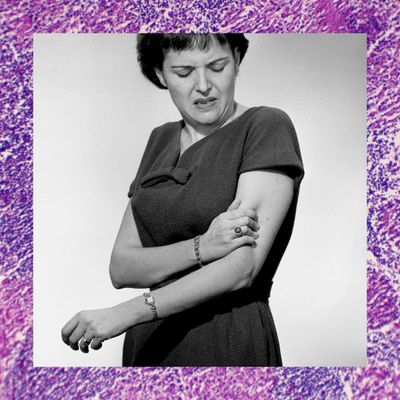
Welcome to Am I Dying, a column that hopes to save you from your late-night WebMD spiraling. You can email us your hypochondriac questions at [email protected].
One time I got a huge, mysterious, PERFECTLY ROUND bruise on my outer left thigh and was convinced I was going to contract deep vein thrombosis. I think I Googled something like “mysterious bruise blood clot die???”
Ah, the mystery bruise, my lifelong companion. As a clumsy and lanky person, I know this phenomenon well: Sure, I know the provenance of some of my bruises, but surely they can’t ALL be from running into things. (Right?) There are too many at any given point for me to keep track of, and I too have occasionally worried that something more serious was going on — especially with those ones that turn yellow. After a momentary teenage fascination with the Habsburgs I wondered if I, too, was a hemophiliac (which can also cause bruising), even though I, unlike so many Habsburgs, am not the result of decades of inbreeding.
Most bruises are innocuous and heal easily on their own, but for those of you who like to take to the internet to research: (a) don’t, but (b) consider first the advice of Glenn Jacobowitz, professor and chief of vascular surgery at NYU Langone Health. “Deep vein thrombosis (or DVT) is a blood clot in the veins,” says Jacobowitz. “If you just find bruising on your body, whether it’s your arms, your legs, or anything — that’s almost never a blood clot.”
The most common symptoms of blood clots (and DVT) are swelling and pain, says Jacobowitz, so a bruise unaccompanied by either shouldn’t be cause for concern. I pointed out that swelling and pain are also fairly common symptoms, and some people might take that kind of information and run with it. Jacobowitz says the important thing to do is to ask yourself whether or not your symptoms can be traced back to any likelier explanations. “It could be a strain, or a muscle cramp that you get in the middle of the night, that can actually tear the muscle and cause pain and swelling,” he says. “So if you can relate it back to one of those things, or any minor trauma, obviously it’s more likely that’s what it is.” If you can’t think of anything at all that might be responsible for those symptoms, you might want to consider getting an ultrasound, but again — bruises aren’t likely to be a part of it.
Most bruises should heal in three to seven days, says Jacobowitz, but that healing process can get pretty gnarly even when you’re perfectly healthy. “If someone bangs themselves and they get a hard lump under their skin, like an avocado-sized lump — say you hit your leg into a side of a table or something — that’s normal,” he says. I was skeptical about the avocado, but Jacobowitz says he’s seen it. “If you think that will freak people out, you can say ‘golf ball,’” he adds. If after a week your bruise isn’t showing signs of healing, or is accompanied by other symptoms (like pain or swelling), then, sure, pay a visit to your primary doctor. They’ll likely check your blood counts and look for clotting abnormalities, says Jacobowitz. And if you find a lot of bruises that can’t be accounted for, he adds, it’s reasonable to go to your doctor to have basic blood tests in order to rule out things like leukemia or low platelet counts (which can also happen for more benign reasons).
So: While mystery bruises are definitely annoying, and it’s probably best if you can keep track of when and where you’re running into things as much as possible, they don’t put you at risk of deep vein thrombosis. Phew.


